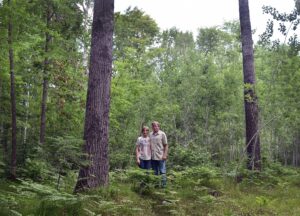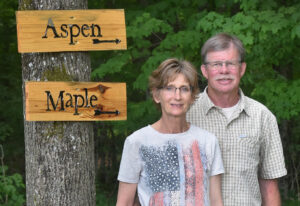By Art Kabelowsky, Wisconsin DNR Division of Forestry

Lori and Jim Livingston manage a species-diverse, 401-acre property outside Medford and adjacent to the Chequamegon-Nicolet National Forest.
What’s one of the most underrated factors behind successful forest stewardship?
Good old-fashioned elbow grease.
“There used to be a time we’d both get up in the morning and work until it got dark,” Lori Livingston said with a laugh. “We don’t do that anymore.”
Still, elbow grease remains the not-so-secret ingredient behind the vast and diverse beauty of Jim and Lori Livingston’s 401-acre property, located adjacent to the Chequamegon-Nicolet National Forest in the Town of Hammel, near Medford in Taylor County.
“The north end is hilly, with a lot of rocks. The south end levels out but gets wet,” Jim Livingston said. “For this part of Wisconsin, we have a lot of diversity.”
“When we first saw this (property), it was just a rockpile,” Lori Livingston said. “Lots and lots of rocks. But we have so many resources here, we’ve been able to make it work.”
One of the important resources behind the Livingstons’ success has been the Wisconsin Department of Natural Resources’ Managed Forest Law (MFL) program, along with its Deer Management Assistance program.
“They’ve done a really great job here. They’ve made a lot of terrific improvements,” said Scott Mueller, a Medford-based DNR tax law forestry specialist.
In all, 236 of the Livingstons’ original purchase of almost 276 acres has been enrolled in the tax law program since 2005. The couple also purchased an adjacent 126-acre Christmas tree farm in 2020; that land is not enrolled in the MFL program.
The Livingstons’ land that does fall under MFL guidelines is a study in forest diversity. Since 2005, the species taken from their property include aspen, basswood, fir, red pine, spruce and mixed hardwoods. They have taken more than 8,000 cords and 11,000 board feet out of the MFL-covered property.
“The tree species that are here are the ones that grow best and match what the area supports,” Jim Livingston said.
Both Jim and Lori earned Bachelor of Science degrees in vocational agricultural education from the University of Wisconsin-River Falls. Throughout their agriculture education careers, they pursued other paths in agriculture and counseling.
The Livingstons decided to leave Owen (in Clark County) and teaching when they had their first of three children in 1989. They settled on the 276-acre, fixer-upper plot located 11 miles northwest of Medford. In the fall of 1993, they built a home on their 276-acre property.
In their early years, they focused primarily on the intense labor and planning required to achieve the stewardship they envisioned for their property. At times, it seemed as if they were cleaning up one mess after another. Rocks and invasive plants were so pervasive that there were spots where they couldn’t see the creek that ran through the property.
At that time, Jim Livingston said he knew about the MFL program, but stayed away because he was under the impression that “there were so many restrictions.”
After their tireless efforts began to show results, with the help of private loggers and foresters, the Livingstons decided to share the beauty of their land with the public.

Lori and Jim Livingston stand at one of the trailheads of Bear Crossing Trails, part of their 401-acre property near Medford.
They opened Bear Crossing Ski Trails in 2000. The 10-mile trail system for cross-country skiing and snowshoeing winds through the heavily wooded areas, with loops set up for various skill levels.
“It’s one of only three groomed trails in Taylor County,” Livingston said. “We’re getting more and more people who travel quite a bit to visit us.”
Following MFL guidelines, the Livingstons don’t charge for use of their trails, but they say users “have been very generous” with donations to cover the costs of grooming, upkeep and expansion of the trail system.
In 2003, Mueller took over as the Taylor County DNR private lands forester. In a discussion with the Livingstons, he was able to dispel some misconceptions about the MFL program.
“Scott and Greg Mitchell recommended a forester, wrote the plan and submitted it,” Jim Livingston said. And before long, the Livingstons became stars of the program.
“The MFL program is flexible and accommodating. You have some things that are hard sideboards, but then you have landowner objectives,” said consulting forester Jake Walcisak. “Once you have a plan in place, it doesn’t have to be set in stone.”
“If the landowner is reasonable, we can figure out a way to make it work,” Mueller said. “If you have a problem that comes up, we can put you in touch with people who can help.”
“(The MFL program) has helped us improve this property and also to get some income from it,” Lori Livingston said.
“When you work with guys like Scott (Mueller) and Jake (Walcisak), the value of your timber goes up,” Jim Livingston said.
Since 2015, the Livingstons worked to eliminate the invasive exotic honeysuckle that had taken hold near their creek. Between that work and rock removal, the Livingstons were able to host their youngest son’s wedding — the family’s second on the property — with seating for 400 set up on an island guarded by a sprawling oak tree.
The Livingstons have a mandatory practice harvest project coming up next year, to include 20-acres of balsam and red pine, as well of 65 acres of mixed hardwood, white pine and some red pine with forest health concerns.
It will be the fourth mandatory practice harvest on the property in a 10-year period. The Livingstons built pinpoint plans for each harvest while maximizing market prices with the help of the MFL staff and many others.
The family also has worked closely on various projects with the Golden Sands Resource Conservation and Development Council and the University of Wisconsin-Stevens Point’s Wisconsin Forestry Center.
“High-quality work is the main goal,” Walcisak said.
All that business-side work makes it possible for the Livingstons to continue with their labor of love.
“It’s good exercise, fresh air and you get to see the results of your work,” Lori said.
“All these programs — working with people like Scott and Jake, learning about timber, cooperating with educational programs — it’s all been such a worthwhile thing,” Jim Livingston said. “We’ve made our needs work together with the MFL program’s needs. We see these guys all the time. There are way more resources out there than people realize.”
“Some landowners aren’t very active in the management of their land,” Mueller said, “but that has never been the case with the Livingstons.”
“The underlying value,” Lori said, “is to take care of what you’ve got.”
